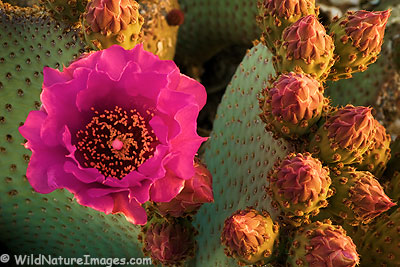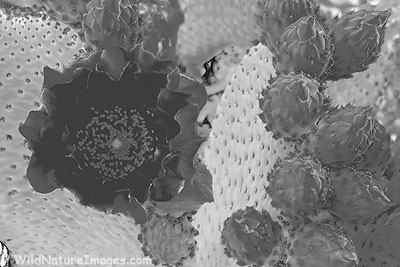
I recently discovered a wonderful new Photoshop tool – the use of saturation masks. This is somewhat of an advanced tool – if you don’t use layers and masks in Photoshop (you should), this won’t make much sense, but I do believe many subscribers here may find it useful.
First, I should begin by explaining I do all my shooting in raw mode with an Adobe 1998 colorspace. By using a somewhat dull colorspace like Adobe 1998, I am able to capture a much broader range of color then I could otherwise. With a colorful colorspace, bright colors can easily be oversaturated and that detail is lost. For example in this photo of bright colorful flower in sunset light, the flower was over saturated right out of the camera, even with a relatively dull color-space.
Since I shoot with a dull color-space, almost all my images need some saturation added to get them back to how I envisioned the scene. Unfortunately, that is easier said then done – with Photoshop, saturation is kind of an all or nothing proposition as some areas will often end up over-saturated, while others under. In the past I have often performed my saturation adjustments in a separate layer, and then taken the time to paint it out (mask) of areas that are oversaturated. In many scenes this just isn’t possible, for example a photo with a meadow of flowers may have hundreds of tiny areas that are oversaturated, so then you are forced to compromise.
You can make saturation adjustments based upon 6 individual colors, but again the same color in one portion of the scene may need more saturation then the same color in a different portion of the scene.
So my new solution is Tony Kuyper’s saturation mask actions. Tony is an excellent photographer and writer, for a better, more detailed description, I would recommend spending some time reading about the actions on his site.
In a nutshell, his actions create two masks based upon the amount of saturation found in an image. Every color in an image opened in Photoshop has varying degrees of saturation. Tony’s action creates masks based upon the degree of saturation. His intensify mask is one where the more saturated the color, the darker the mask, likewise the undersatrated colors are light to white in the mask. As you may know with masks, black blocks the adjustment effect, in this case saturation, and whites reveal the effect. This mask allows you to saturate just the under saturated colors, while leaving the saturated colors relatively unaffected.
Here is the actual intensity mask for this image:

You can see the actual flower is almost black – that is because those colors are fully saturated. In addition, the green portion of the cactus is fairly white in this mask. So you can see, any adjustment to saturation is going to effect the white or unsaturated colors far more then the dark, or saturated colors. This is really a powerful tool.
His actions also include one that creates a rescue mask. With the rescue mask, the under-saturated colors are blocked (dark or black) and the over saturated colors are light. This allows you to desaturated only the over saturated colors. I had to do that with this image as the reds in the flower were blown out.
Since these masks are created directly from the actual image, they are completely self-feathing. In the past I would have used a mask and tried to paint out the flower – I’m sure I would have missed a few spots, and gone over a little in other areas – that doesn’t happen with these masks.


Comments 9
That is an awesome photo Ron! Damn! it is practically glowing. it might take me a while to digest this information but it is good to know. what I have found frustrating is dealing with pure yellow areas of wildflowers, petals, etc… because it is the fastest color to posterize even with little adjustment and yet at times it still looks undersaturated in some cases.
Hey Ron
I SO need to lean about this stuff. Coming from you this is a huge recommendation for Tony’s masks, I’ve always thought your work is some of the best processed stuff I see on the web – it always snaps without being overdone. How long have you been using the masks?
Cheers
Carl
Hey Ron
How about posting a copy of the untouched file, straight from RAW? that’d be cool to see.
Cheers
Carl
Author
Thanks guys!
You know Carl, I have just started playing around with his actions, so aside from a couple of photos on the blog here, I really haven’t used it, but I really think it is a useful tool I will probably use it a lot.
Glad to hear you say our stuff isn’t overdone because I think we border on that at times – it is like a pendulum, sometimes I think our stuff is overdone, then sometime I think it underdone, the harder I look the more uncertain I become. 🙂
That is a good idea – I will have to dig up the original.
Author
Here is the unadjusted verion:
It may be hard to tell without them side by side, but you may notice the flower is over saturated, and lacks detail, while the buds were under saturated, and didn’t glow in the sunset light like they were at the time. With the saturation action, I was able to desaturated the flower, and saturate the buds.
Great shot Ron. I have been using Tony’s luminosity masks for awhile and love them. Incredibly powerful stuff for the control they offer. I still haven’t tried the saturation one, but your post reminds me I need to.
Hey Ron,
That shows a lot .. wow .. what a huge difference some subtle changes can make to the overall presentation. I’m gunna have to run by Tony’s site and get that set of actions off him … of course, I’m about to leave the world of computing for a little while too, so it may be a project for later. 🙂
I tried his luminosity masks a year or so ago, when he first posted them on NPN, and it was a total disaster. 🙂
Thanks for posting the 2nd shot.
Cheers
Carl
Author
Thanks Mark, I think you will like those actions.
You are welcome Carl, I found these actions far easier to use and master then the luminosity masks.
I don’t think you are going to mind escaping the computer world for awhile! When do you leave?
Ron
Hey Ron
Thanks for the information man – I’ll look into them for sure.
“When do you leave?”
The morning.
Cheers
Carl